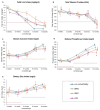Micronutrient Intake during Complementary Feeding in Very Low Birth Weight Infants Comparing Early and Late Introduction of Solid Foods: A Secondary Outcome Analysis
- PMID: 39408246
- PMCID: PMC11478718
- DOI: 10.3390/nu16193279
Micronutrient Intake during Complementary Feeding in Very Low Birth Weight Infants Comparing Early and Late Introduction of Solid Foods: A Secondary Outcome Analysis
Abstract
Background/Objectives: The complementary feeding period is crucial for addressing micronutrient imbalances, particularly in very low birth weight (VLBW) infants. However, the impact of the timing of solid food introduction on micronutrient intake in a representative VLBW population remains unclear. Methods: This prospective, observational study investigated micronutrient intake during complementary feeding in VLBW infants categorized based on whether solids were introduced early (<17 weeks corrected age (CA)) or late (≥17 weeks CA). Nutritional intake was assessed using a 24 h recall at 6 weeks CA and with 3-day dietary records at 12 weeks and at 6, 9, and 12 months CA. Results: Among 218 infants, 115 were assigned to the early group and 82 to the late group. In total, 114-170 dietary records were valid for the final analysis at each timepoint. The timepoint of solid introduction did not affect micronutrient intake, except for a higher iron and phosphorus intake at 6 months CA in the early group (early vs. late: iron 0.71 vs. 0.58 mg/kg/d, adjusted p-value (p-adj.) = 0.04; phosphorus 341 vs. 286 mg/d, p-adj. = 0.04). Total vitamin D, calcium, zinc, and phosphorus greatly met intake recommendations; however, dietary iron intake was insufficient to equalize the iron quantity from supplements during the second half year CA. While nutrient intakes were similar between infants with and without comorbidities, breastfed infants had lower micronutrient intakes compared with formula-fed infants. Conclusions: This study suggests that micronutrient intakes were sufficient during complementary feeding in VLBW infants. However, prolonged iron supplementation may be necessary beyond the introduction of iron-rich solids. Further research is essential to determine micronutrient requirements for infants with comorbidities.
Keywords: calcium; complementary feeding; iron; micronutrient intake; phosphorus; preterm infants; vitamin D; zinc.
Conflict of interest statement
Nadja Haiden reports consulting fees from Medis, MAM, Baxter, and Nestle and honoraria for lectures from Nestle, Baxter, Danone, and Hipp outside the submitted work. All other authors have no conflicts of interest to report.
Figures





Similar articles
-
Macronutrient Intake during Complementary Feeding in Very Low Birth Weight Infants Comparing Early and Late Introduction of Solid Foods: A Secondary Outcome Analysis.Nutrients. 2024 Oct 9;16(19):3422. doi: 10.3390/nu16193422. Nutrients. 2024. PMID: 39408387 Free PMC article.
-
Complementary feeding and micronutrient status: a systematic review.Am J Clin Nutr. 2019 Mar 1;109(Suppl_7):852S-871S. doi: 10.1093/ajcn/nqy266. Am J Clin Nutr. 2019. PMID: 30982869
-
Effect of timing of introduction of complementary foods on iron and zinc status of formula fed infants at 12, 24, and 36 months of age.J Am Diet Assoc. 2001 Apr;101(4):443-7. doi: 10.1016/S0002-8223(01)00114-6. J Am Diet Assoc. 2001. PMID: 11320951 Clinical Trial.
-
Effects of early introduction of solid foods on nutrient intake in preterm infants during their 1st year of life: a secondary outcome analysis of a prospective, randomized intervention study.Front Nutr. 2023 May 18;10:1124544. doi: 10.3389/fnut.2023.1124544. eCollection 2023. Front Nutr. 2023. PMID: 37275631 Free PMC article.
-
Controversies in neonatal nutrition.Pediatr Clin North Am. 1986 Feb;33(1):65-89. doi: 10.1016/s0031-3955(16)34970-7. Pediatr Clin North Am. 1986. PMID: 3081866 Review.
References
-
- Baldassarre M.E., Panza R., Cresi F., Salvatori G., Corvaglia L., Aceti A., Giannì M.L., Liotto N., Ilardi L., Laforgia N., et al. Complementary feeding in preterm infants: A position paper by Italian neonatal, paediatric and paediatric gastroenterology joint societies. Ital. J. Pediatr. 2022;48:143. doi: 10.1186/s13052-022-01275-w. - DOI - PMC - PubMed
-
- Fewtrell M., Bronsky J., Campoy C., Domellöf M., Embleton N., Fidler Mis N., Hojsak I., Hulst J.M., Indrio F., Lapillonne A., et al. Complementary Feeding: A Position Paper by the European Society for Paediatric Gastroenterology, Hepatology, and Nutrition (ESPGHAN) Committee on Nutrition. J. Pediatr. Gastroenterol. Nutr. 2017;64:119–132. doi: 10.1097/MPG.0000000000001454. - DOI - PubMed
Publication types
MeSH terms
Substances
Grants and funding
LinkOut - more resources
Full Text Sources
Medical
Miscellaneous

